Earthquakes and Earth's Interior
1/68
There's no tags or description
Looks like no tags are added yet.
Name | Mastery | Learn | Test | Matching | Spaced |
|---|
No study sessions yet.
69 Terms
Which of the following is characterized by brittle, rigid, and solid?
Lithosphere
Earthquakes in California are?
Due to stick-slip behavior along the San Andrea fault.
The Earth's magnetic field is thought to be a direct result of?
Convection in the outer core
Which type of wave is a compressional body wave?
P-wave
The P-wave and S-wave shadow zones are similar in that?
No seismic waves are recorded there
A tsunami?
May be just a broad, gentle swelling out at sea but grows as it approaches shore
What rock makes up the oceanic crust?
Basalt
What rock makes up the continental crust?
Granite
Earthquake prediction is not highly reliable, but geologists do know?
More earthquakes happen along plate boundaries than happen at intraplate locations
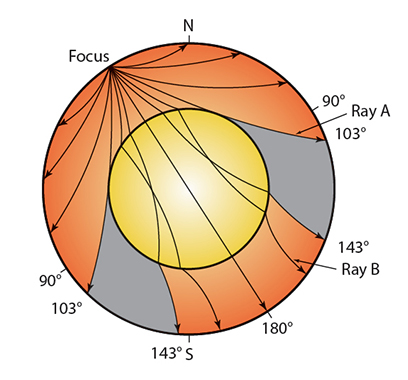
The areas shown in gray occur because?
P-waves are refracted at the core-mantle boundary.
The Modified Mercalli Intensity scale measures?
Earthquake damage
What is a shadow zone?
An area in the subsurface of the Earth where seismic waves are not seen
The S-wave shadow zone indicates?
The outer core is liquid
Liquefaction?
Can affect sand layers below the ground surface and cause them to erupt as sand volcanoes or sand boils
The crust, core and mantle are the main layers of the Earth and are separated based on their?
Composition
The P-wave shadow zone marks the?
Core-mantle boundary
Which of the following is a good technique for building safer structures in an earthquake zone?
Use wood-frame construction.
What rock makes up the oceanic crust?
Basalt
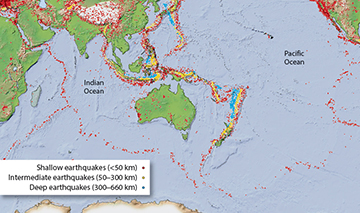
The earthquake foci pattern east of Australia and just north of New Zealand indicates which tectonic setting?
Convergent plate boundary
To find the location of an earthquake's epicenter, you need to calculate the distance from the epicenter to ____ different seismometer stations.
3
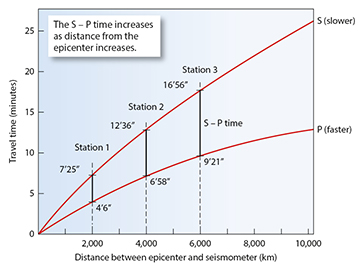
Interpret the travel-time curve shown. Approximately how many minutes elapsed between the arrival of the first P-wave and the arrival of the first S-wave at Station 3?
7
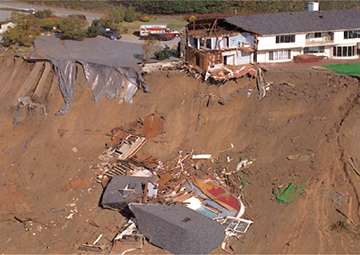
Which peripheral hazard of earthquakes caused the damage shown in the photo?
Landslide
Which type of seismic wave has the fastest velocity?
P-wave
Which of the following does NOT affect the severity of damage from an earthquake?
Weather
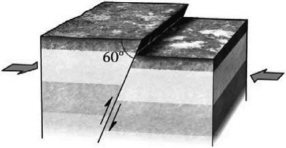
During an earthquake, if the hanging wall slides upward relative to the footwall and if the fault is steep (closer to vertical than horizontal), then the fault is termed a __________ fault. Refer to the following figure for an example of such a feature.
Reverse
Wet and unconsolidated substrates are uniquely susceptible to __________ during an earthquake.
Liquefaction
The quantity of motion that occurs along a fault is termed?
Displacement
Which two scales are the most similar?
The Richter and the Magnitude Moment Scales
As a seismologist, you are asked to write a report on the latest earthquake. Your boss want to know the details of the earthquake in terms of damaged caused to the city and surrounding area. In order to get this type of information, which scale would you use?
the Modified Mercalli scale
The Magnitude Moment Scale measures what?
The total energy released by an earthquake

According to the image below, which seismic wave phase is likely to cause the most damage?
Surface wave
Which type of waves are compressional in nature?
P
Earthquakes that occur in a band called the __________ can be used to track the motion of subducted oceanic lithosphere.
Wadati-Benioff zone
The Modified Mercalli Scale measures what?
The damage caused by an earthquake
A tsunami is?
A sea wave generated by a displacement of water
The Mercalli intensity scale tends to be very subjective and thus is generally only used for historical earthquakes that were near people but were not recorded by seismometers. The Mercalli scale may be considered subjective because?
Relies on testimony from people
Which earthquake scale is used to assess the effects of an earthquake on humans and human-made structures?
Mercalli scale
A primary force opposing motion on all faults is?
Friction
The __________ the earthquake, the LESS severe the damage will be
farther you are from
A surface along which rock on opposed sides is offset by an earthquake-induced slip is called a?
Epicenter
A surface along which rock on opposed sides is offset by an earthquake-induced slip is called a?
Fault
Which type of waves are shear waves?
S
The larger the __________ of the wave, the MORE severe the damage will be.
Amplitude
Long-term prediction methods include(s)?
Seismic risk assessment
The moment magnitude is based on the __________ and __________ of the earthquake.
Amplitude; displacement
You are visiting a relative in California, and while you are at the park, an earthquake occurs. You notice what looks like wave motion on the surface of the Earth. What types of waves are you actually seeing?
Surface waves
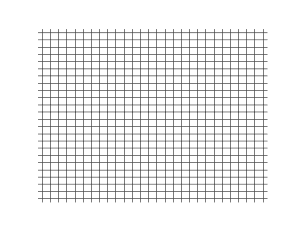
Which type of wave moves like this?
P
The Richter Scale measures what?
The largest jolt of energy caused by an earthquake
Which of the following statements is true?
Earthquakes can occur at both plate boundaries and in the middle of a continent
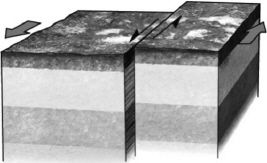
If a fault is nearly vertical in orientation and the two walls of rock on opposite sides slide past one another horizontally, the fault is termed a __________ fault. Refer to the following figure for an example of such a feature.
strike-slip
Moderate- and deep-focus earthquakes occur along ONLY
convergent-plate boundaries.
When reading a seismogram printout of an earthquake recording, which wave will the first to register?
P
Vertical motion seismographs record earthquakes by producing a squiggly diagram called a?
Seismogram
The point within Earth where an earthquake takes place is termed the
Focus
S-waves are unable to pass through the Earth’s outer core, which indicates that the outer core is?
Liquid
Generally, which type of earthquake waves travel with the slowest velocity?
Surface waves
Earthquakes can often produce __________ by breaking gas lines.
Fires
At a minimum, how many seismic stations are necessary to locate the epicenter of an earthquake?
Three
Much of the capitol city of Port-au-Prince was destroyed during the 2010 Haiti earthquake even though similarly sized earthquakes in other cities did very little damage. What caused so much damage during the Haiti earthquake?
A tsunami wiped out the city.
Why do deep-focus earthquakes occur along convergent plate boundaries? Why do they not occur along divergent or transform boundaries?
Convergent plate boundaries result in subduction where one plate descends below another. Deep-focus earthquakes occur within the subducted lithosphere as it sinks down through the asthenosphere. This does not happen along divergent or transform boundaries where the earthquakes are all relatively shallow.
How is the Mercalli intensity scale used to determine the magnitude of an earthquake? What errors might be associated with this technique?
The Mercalli intensity scale defines earthquake intensity by assessing both the damage that the earthquake caused and people’s perception of the shaking. The main issue is that testimonies can be very subjective among a group of people
Explain why tsunamis are NOT tidal waves.
Tsunamis are created by large displacements of water caused by earthquakes, landslides, or volcanic eruptions. Tsunamis are associated with displacements of the seafloor, which displace water in the ocean; this is different from tides which are the result of gravitational attraction between the Earth, Moon, and Sun.
Where do earthquakes occur? Please explain your answer in the context of plate tectonics.
Earthquakes tend to occur along plate boundaries. This includes convergent, divergent, and transform boundaries. However, occasionally intraplate earthquakes—those occurring away from plate boundaries—do happen.
Describe two earthquake-related hazards.
Earthquakes involve ground shaking, which can be extremely detrimental to human structures. Landslides can result from seismic shaking. Liquefaction happens when ground shaking causes sand grains to try to settle more tightly together, which allows water pressure to build up so that it pushes the grains apart, causing the once solid ground to behave like quicksand; this can cause damage to structures. Fires have been associated with earthquakes because ground shaking can upset open flames, topple power lines, and rupture gas lines; all of these can start a fire. Tsunamis are large waves that are triggered by displacement of seawater; they are associated with earthquakes that take place near coastal regions. After the earthquake is over, disease may threaten lives in an earthquake-damaged region.
What is the Moho? How was it discovered?
The Moho is the boundary between the crust and mantle. It was discovered by Mohorovicic, who observed that P-waves arriving at seismometers distant from an earthquake epicenter arrived with greater velocities than those arriving proximal to the epicenter. From this, he assumed that P-waves reaching distant seismometers traveled in part through the mantle and that their velocity was greater in the mantle.
What phases of matter can a P-wave travel through? An S-wave? How has this helped us to have a better understanding of the layers of our Earth?
P-waves can travel through solids, liquids, and gases. S-waves can only travel through solids. By observing the way earthquakes arrive at seismometers around the globe, scientists are able to get a better understanding of the layers of the Earth. Specifically the inability of S-waves to pass through the outer core tells us that it must be at least partially molten. Scientists can also observe how P- and S-waves reflect, refract, or change velocity at various boundaries within the Earth, giving us clues about the nature of the layers.
What causes earthquakes? Explain elastic rebound theory.
Where do earthquakes occur? Please explain your answer in the context of plate tectonics.
Earthquakes tend to occur along plate boundaries. This includes convergent, divergent, and transform boundaries. However, occasionally intraplate earthquakes—those occurring away from plate boundaries—do happen.
What is the difference between a dip-slip fault and a strike slip fault? Provide examples of each. Draw a cross section of a normal and reverse fault. For each, list the stress involved and changes in the length of the crust, if any.
Normal faults form in response to tension and involve lengthening of the crust. Reverse faults form in response to compression and involve shortening of the crust.
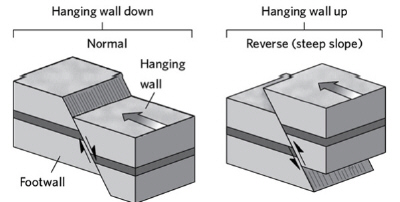
What types of geologic structures would you expect to find in an area that had undergone compression?
Answers will vary; however, students should mention folding, reverse and thrust faulting, and perhaps tectonic foliation. They should not mention normal faulting.